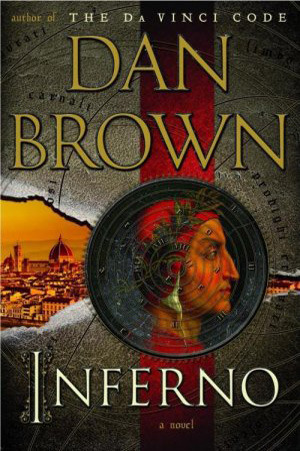Dan Brown’s books come laden with so many expectations – and not all good. Savaged by many critics, and often unfairly, it is for his fans to decide whether or not one of his books deserve the kudos the sales suggest and, if you go by those alone, then his books are not only popular, but eminently readable.
Inferno, the fourth Robert Langdon book, is a strange and ofttimes predictable beast. While I have thoroughly enjoyed the previous Langdon outings (love a book that makes an academic an intellectual and action star – shades of Indiana Jones – and has as its core mystery literature, art and symbols) Inferno, for all that it presages the passionate poet Dante, flames and the burning heat of hell, left me mostly cold.
Once again, a quest features and a puzzle that’s centred on a famous work lies at the heart of the mystery, a mystery that begins when Langdon awakes in hospital in Florence with no mem ory of how he got there or why. When strangers try to take his life and a beautiful and clever female doctor offers rescue and potentially some answers to the blanks his memory has become, Langdon jumps (literally) at the chance.
ory of how he got there or why. When strangers try to take his life and a beautiful and clever female doctor offers rescue and potentially some answers to the blanks his memory has become, Langdon jumps (literally) at the chance.
Pursued relentlessly, able to solve cryptic questions and read the stories into and behind famous and old art, Langdon moves around Europe and Turkey, discovering friends and enemies with abandon. All the while, the reason for his memory lapse and deadly pursuit starts to become clear – and, if Langdon doesn’t find the answers required of him in time, then not only is his life forfeit, but the safety of the world is at stake.
Blending very relevant and fascinating modern science conundrums and a pressing social issue (no pun intended), Langdon is once again up against an all-powerful megalomaniac who will stop at nothing to see his vision realized.
Brown has the formula for these “intellectual thrillers’ down pat now. Only, the rush of Angels and Demons, the development of plot and character that made his earlier works retrospectively well-liked, has been sacrificed to a degree for too much didacticism. In many ways, Inferno is part travelogue and part historical, literary, art, and scientific treatise, as if Brown wants to prove his research and travel credentials by packing all the information into the novel. As a result, some of the characters function as little more than mouthpieces who serve this purpose alone. We are given asides about art, buildings, and scientific research – not all immediately pertinent to the story – that could have been delivered more subtly or not at all. They tell don’t show and the story suffers as a consequence. Perhaps this is also why so many of the characters are black or white in terms of their ideologies and motivation. Even when Brown tries to paint shades of grey (and he does) they are tinged with obvious good or evil hues that makes them unsurprising and sometimes dull.
For all that, this is still a page-turner, even if sometimes I was turning them because I wanted the tale to end. Overall, however, it’s a good holiday, escapist read. I knew what I was getting and in that sense, wasn’t disappointed. I do think some critics judge Brown as if he should have written War and Peace, Mrs Dalloway, or The Dubliners or at least judge him by weighty and incomparable literary criteria, when what he does write is thriller cum potboilers that are, as sales and other evidence attest, definitely crowd pleasers.
